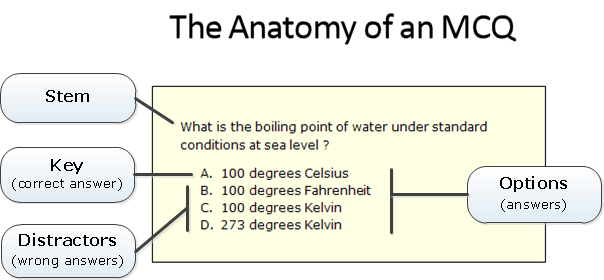ExamOnline supports a number of question types, with sophisticated computerised marking for gap-fill, numeric, and short-answer questions, and human marking for essay questions.
But there is no getting away from it, multiple-choice questions (or MCQs as they are commonly known) are by far the most commonly used questions in online tests (up to 95% of all online test questions used in UK University e-assessments are MCQ according to one survey, and the prevalence in the business world is likely to be even higher).
But here’s the rub : while we are all familiar with MCQs, writing good MCQs can be tricky. So here is a brief guide to writing good multiple-choice questions.
The Anatomy of a Multiple-choice Question
Let’s start by familiarising ourselves with the constituent parts of a multiple choice question. These are :
- The stem : the text which asks the question
- The options : the list of possible answers
- The key : the correct answer
- The distractors : the incorrect answers
This is illustrated below.
The number of options can of course vary, but either 4 or 5 are recommended. There is no recognised value in adding more distractors, and the effort involved in coming up with them may be considerable. So far so good, but how do we go about writing good multiple choice questions? It starts with one simple question.
What Do I Want to Test ?
Before writing the question, identify the one point you want it to test. Actually ask yourself, what do I want to test with this question ? Now write your answer down, and keep it in mind as you write the question stem and the options. Refer back to it as you refine and review the question.
Writing The Question Text (Stem)
So how to write a good multiple choice stem ? Present a single, definite statement to be completed or answered by one of the several given choices. Sounds easy, but there are many pitfalls [view an example]. You can avoid most of these if you adhere to the following rules. Make sure that your question:
- tests the important knowledge, and only that knowledge;
- uses simple, clear language, using as few words as possible [view an example];
- is free from superfluous information or detail [view an example];
- has only one correct answer, and that this answer is unambiguously correct;
And here are some things to avoid :
- avoid giving clues in the question [view an example];
- avoid asking negative questions (e.g. “Which of the following animals is not a mammal ?”);
- avoid double negatives;
- avoid subjective language “Which of the following do you think is…”;
- avoid the use of personal pronouns (“You”, “They” etc.);
- avoid words like ‘could’, ‘would’, ‘might’;
- avoid repeating the same text in all of the options – move the text to the stem instead [view an example];
Once you have a good draft of the stem, you can move onto writing the list of possible answers : the options.
Writing The Options
The options are the list of possible answers, consisting of one correct answer (the key) and a number of incorrect answers (the distractors). Make sure that there is only one correct answer, and that this answer is unambiguously correct. That’s the easy bit though. Creating good distractors is the hardest, but also the most important, part of creating a good multiple-choice question.
Writing Good Distractors
Here is a checklist for your distractors. Create distractors which :
- are plausible and sensible [view an example];
- are, where possible, based on common misunderstandings of the topic being tested;
- are comparable in length and use of grammar to the correct answer [view an example];
In addition, bear in mind that :
- correct sounding distractors are good for the poorly prepared candidate [view an example];
- true statements that do not answer the question are good distractors;
And here are some things to avoid :
- Avoid the use of such words as “always,” “never,” and “all”, as these can act as a cue (candidates are likely to rule such universal statements out of consideration);
- Don’t use words such as “not”, “never” or “always” to make an option incorrect;
- Avoid using “All of the above”, since if a candidate recognises one of the distractors as being incorrect, they have effectively eliminated the “all of the above” option as well;
- Do not create distractors that are so close to the correct answer that they may confuse candidates who really know the answer. Distractors should differ from the key in a substantial way, not just in some minor nuance of phrasing or emphasis.
So there you have it, a crash course in writing good multiple choice questions. But here’s one final piece of advice: ask a colleague to review, and actually try out, your questions. Experience suggests that we often can’t see the problems with our own questions.

